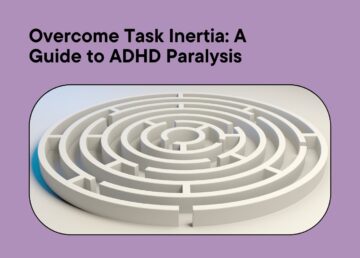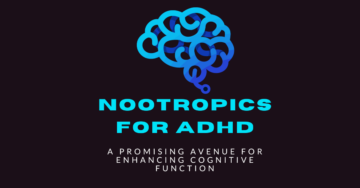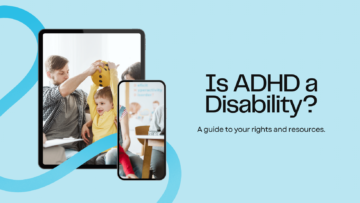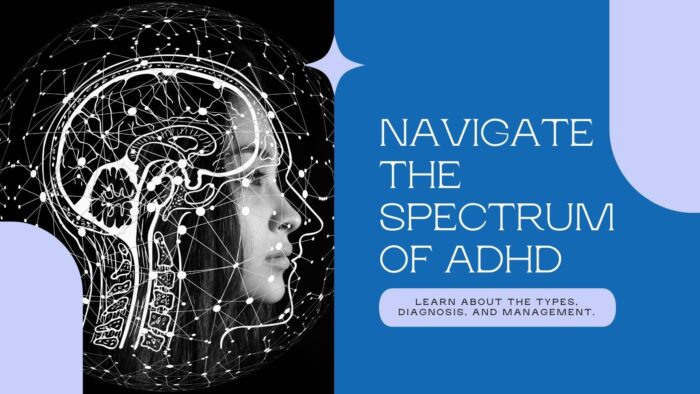
Attention Deficit Hyperactivity Disorder (ADHD) is a neurodevelopmental disorder often characterized by persistent patterns of inattention, impulsivity, and hyperactivity. These symptoms can significantly impact daily life.
Understanding the different types of ADHD is crucial for accurate diagnosis and effective treatment.
ADHD presents in three primary types: inattentive type, hyperactive-impulsive type, and combined type.
Each type has distinct characteristics and symptoms, making it essential to differentiate to provide tailored care.
Breaking Down the Types of ADHD
Before we delve into the specifics of the disorder’s types, let’s first understand the fundamental categories that ADHD can be classified into.
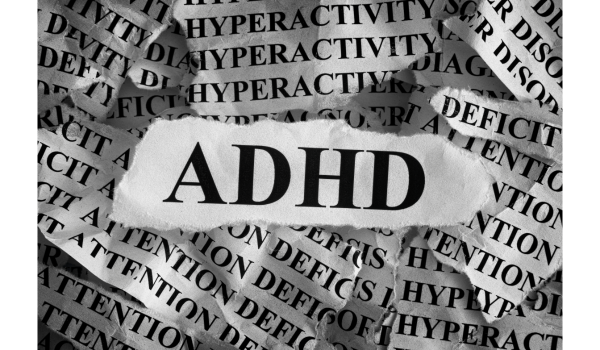
Inattentive type ADHD
Inattentive type ADHD, previously known as ADD (Attention Deficit Disorder), is characterized by inattentive behavior: difficulty in sustaining attention, following through on tasks, and being easily distracted.
Individuals with inattentive type of ADHD type may seem forgetful, disorganized, are easily distracted by external stimuli, can have time management issues, and struggle with tasks that require sustained mental effort.
Common inattentive ADHD symptoms include:
- Difficulty sustaining focus on tasks or activities, frequently making careless mistakes.
- Easily distracted by external stimuli or unrelated thoughts.
- Forgetfulness in routine tasks and daily activities, such as losing items or missing appointments.
- Difficulty organizing tasks and following instructions.
While these are the primary symptoms of the inattentive type, the list can be extended as each presentation is is different.
Hyperactive-impulsive type ADHD
Hyperactive-impulsive type of ADHD primarily manifests as impulsive behaviors and hyperactivity.
Individuals with the hyperactive-impulsive type may find it challenging to wait their turn, engage in excessive talking, and act on impulse without considering the consequences.
This is especially relevant for children as they have not yet learned certain behaviors expected in social situations.
Hyperactive-impulsive ADHD can be defined by the following symptoms:
- Impulsive behavior, leading to hasty decision-making and frequent interruptions.
- Difficulty waiting in line or taking turns, often blurting out answers or finishing others’ sentences.
- Restlessness, constantly fidgeting or tapping hands and feet.
- Inability to engage in quiet activities, sit still for extended periods, or other behavior problems.
Combined type ADHD
Combined type ADHD is the most common presentation that combines symptoms of inattention, hyperactivity, and impulsivity.
Most children and adults with combined type ADHD exhibit a wide range of symptoms – they shor inattentive behavior and hyperactive-impulsive signs as well.
Unraveling the Causes of ADHD
Now that we’ve explored the types of ADHD, let’s delve into the factors that contribute to its development.

Genetic factors
Genetic factors play a significant role in ADHD development. Research indicates that if a close family member has ADHD, there is a higher likelihood of inheriting the condition due to shared genetic vulnerabilities – the heritability of this condition ranges from 60–90%.
The exact causes of attention deficit hyperactivity disorder are not yet fully understood. It is suspected that both environmental and genetic factors and environmental factors play a role.
Brain structure and function
Studies have revealed certain differences in brain structure and function in individuals with ADHD.
Due to structural changes in the brain, it’s suspected that brain activity is also affected – brain imaging has shown that there are structural changes in the maturation of the white matter and grey matter density in areas related to attention and impulse control
These differences can contribute to the disorder’s symptoms and presentations.
Environmental factors
Environmental factors, including prenatal exposures to toxins and early childhood experiences, can also influence the development of ADHD.
Maternal smoking, alcohol use during pregnancy, and lead exposure have been linked to an increased risk.
Additionally, insufficient exposure to nutrients, such as copper, folic acid, iron, and others, can increase the risk of developing ADHD.
Neurodevelopmental factors
Disruptions in critical stages of brain development, often occurring during pregnancy or early childhood, may contribute to the development of ADHD.
Neurodevelopmental factors, such as premature birth, low birth weight, and other pre/perinatal factors can increase the risk of ADHD.
Associated medical conditions
Similarly as with neurodevelopmental factors, certain medical conditions, such as low birth weight, premature birth, or brain injuries, are associated with a higher risk of ADHD.
Common myths about ADHD causes
Addressing common myths about ADHD causes is essential for dispelling misinformation. It’s crucial to understand that ADHD is not caused by factors like excessive sugar consumption or poor parenting practices.
Some people mistakenly believe that ADHD is not a legitimate medical condition. In reality, it is a well-recognized neurodevelopmental disorder with substantial scientific research supporting its existence.
Additionally, there’s a belief medication is required to treat ADHD. In reality, while medication can be an effective part of treating ADHD, it is not the only approach. Behavioral therapy, lifestyle modifications, and educational support can also helps manage ADHD symptoms.
Navigating the ADHD Diagnosis Process
With a deeper understanding of ADHD’s potential causes, let’s now focus on the crucial process of getting ADHD diagnosed. It’s essential to remember that only a qualified mental health professional can diagnose ADHD in adults and children.
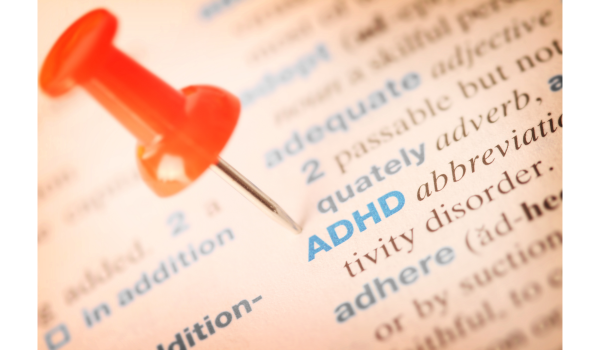
Diagnostic criteria set by the American Psychiatric Association
The American Psychiatric Association has prepared a Diagnostic and Statistical Manual of Mental Disorders (DSM-5) that provides specific criteria for diagnosing ADHD, including the duration and severity of symptoms.
According to American Psychiatric Association, specific symptoms must be present for at least 6 months and interfere with daily functioning. The criteria for diagnosing attention deficit hyperactivity disorder outlined in the Diagnostic and Statistical Manual of Mental Disorders are:
- Five or more symptoms (out of nine symptoms) of inattention. The individual fails to pay close attention to details, makes careless mistakes, has difficulty sustaining attention in demanding tasks, seems not to listen when spoken to, is forgetful, and distracted by external stimuli.
- Six or more hyperactive and impulsive symptoms. For example, trouble waiting for his or her turn to act or speak, trouble listening to and paying attention to directions, talking excessively, fidgeting, and difficulty staying still.
- Symptoms across multiple settings. The inattentive symptoms should be present in two or more settings – home, school, or work – to rule out situational factors.
- Symptoms interfere with functioning. The inattentiveness must lead to impairment in academic, occupational, social, or day-to-day activities, affecting the person’s life and ability to meet their potential. These could be forgetting to make or return phone calls, difficulty paying attention in classes, conversations, etc.
Symptoms are not better explained by other disorders. ADHD diagnosis fits the situation best, and symptoms cannot be better explained by other mental health condition (mood disorder, anxiety disorder, personality disorder, etc.)
Diagnosing different ADHD types
While the diagnostic processes for inattentive ADHD, hyperactive-impulsive, and combined types of ADHD ar the same, it’s good to collect extra details that could be relevant for the medical professional.
If you, your loved one, or your child would like to get diagnosed with ADHD, collecting a detailed history from family members, teachers, and the individual themselves can prove to be beneficial.
Additionally, emphasizing what settings trigger the symptoms most. For example, inform your doctor that you exhibit symptoms of distractability and forgetfulness at school or work the most.
Moreover, brain imagingcan aid in understanding ADHD but is not commonly used for routine diagnosis.
Treatment Approaches for ADHD
Once a proper diagnosis is received, there are various treatment options available to manage attention deficit hyperactivity disorder (ADHD) symptoms effectively.
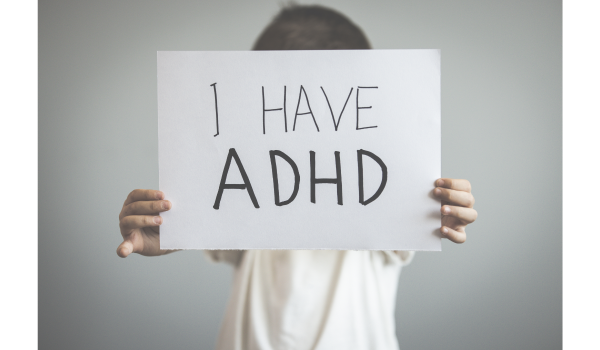
Stimulant medications
Stimulant medications, such as methylphenidate (Ritalin, Concerta) and amphetamine-based drugs (Adderall, Vyvanse) are commonly prescribed to manage ADHD symptoms.
These ADHD medications can improve attention, focus, and can be prescribed to both children and adults. It’s essental to remember that all types of ADHD medications should only be used according to the doctor’s guidelines.
Non-stimulant medications
Non-stimulant ADHD medications, like atomoxetine and guanfacine, offer an alternative for individuals who do not respond well to stimulants or have contraindications.
Moreover, tricyclic antidepressants (TCA) – imipramine and desipramine – can be used for people who do not respond well to stimulants and non-stimulant ADHD medications.
Tricyclic antidepressant medications affect norepinephrine levels in the brain. Usually, TCAs are not considered a first-line treatment option.
Behavioral therapy and other interventions
There are several non-medication treatment options for this disorer. Behavioral therapy, including cognitive-behavioral therapy (CBT) and psychoeducation, can help individuals with ADHD develop essential skills, manage impulsivity, and improve their overall quality of life.
Support groups, online and offline, and educational interventions can provide valuable resources and a sense of community. Support groups can be a great choice for both individuals with ADHD and their families.
Sensa is an app founded on cognitive behavioral therapy (CBT) principles and developed with mental health professionals. The app is designed to support individuals dealing with attention deficit hyperactivity disorder (ADHD) and other mental health conditions. We have also compiled a list of other ADHD apps which can be helpful to alleviate some of the symptoms.
It equips users with a range of options that help effectively manage symptoms, establish routines, enhance time management, acquire coping strategies, and bolster overall self-control.
Conclusion
All in all, understanding your type of ADHD, the causes of attention deficit hyperactivity disorder, and available treatments is essential for accurate diagnosis and effective treatment.
By recognizing the nuances of ADHD and its differfent presentations, individuals can receive the support and treatment they need to manage their symptoms and lead fulfilling lives.
FAQs on ADHD Types and Symptoms
ADHD is a vast topic, and it can be difficult to get a grasp on it immediately. Therefore, it’s good to have concentrated information on types, symptoms, and possible treatment options.
Are there 3 or 7 types of ADHD?
According to the DSM-5, ADHD is categorized into three main types.
What types of ADHD are there?
The three types of the disorder are:
- Inattentive type ADHD: This type is characterized by difficulties in sustaining attention and is often referred to as ADD, although this term is now outdated.
- Hyperactive-impulsive type ADHD: Individuals with this type exhibit impulsive behaviors and hyperactivity.
- Combined type ADHD: This is the most common presentation, involving a combination of symptoms from both inattentive and hyperactive-impulsive categories.
What are the different types of ADHD medication?
Typically, people with ADHD have two options for ADHD medication – stimulants and non-stimulants. They also come in different forms and brand names.
- Stimulant medications. These include drugs like methylphenidate and amphetamine-based medications. They are commonly prescribed to improve attention, focus, and impulse control in individuals with ADHD.
Non-stimulant medications. Non-stimulant options such as atomoxetine, guanfacine, and TCAs are used when stimulants are not suitable or effective. They offer an alternative approach to managing ADHD symptoms.
What is non hyper ADHD?
What is commonly referred to as “non-hyper ADHD” is now known as predominantly inattentive ADHD (PI-ADHD). It is one of three subtypes of ADHD, characterized by persistent difficulties with attention, focus, and concentration. Unlike the predominantly hyperactive/impulsive (PH-ADHD) subtype, individuals with PI-ADHD do not exhibit excessive physical activity or impulsive behavior. Common symptoms of PI-ADHD include:
- Difficulty staying focused on tasks or conversations
- Frequent daydreaming or mind wandering
- Distractibility by external stimuli
- Difficulty following instructions or completing assignments
- Poor organization and time management
- Increased forgetfulness
Despite the lack of overt hyperactivity, PI-ADHD can significantly impact daily functioning, academic progress, and social interactions. It is important to seek professional evaluation and treatment for PI-ADHD to manage symptoms and optimize overall well-being.
What is the rarest type of ADHD?
The rarest type of ADHD is the hyperactive-impulsive subtype without inattentive or distracted behavior. This subtype is characterized by excessive physical activity, impulsive actions, and a lack of focus, but without the inattentive symptoms typically associated with ADHD. This subtype is more common in boys than girls and is often overlooked or misdiagnosed as other conditions, such as anxiety or oppositional defiant disorder.
References
- Milich, R., Balentine, A.C. and Lynam, D.R., 2001. ADHD combined type and ADHD predominantly inattentive type are distinct and unrelated disorders. Clinical psychology: science and practice, 8(4), p.463.
- Collings, R.D., 2003. Differences between ADHD inattentive and combined types on the CPT. Journal of Psychopathology and Behavioral Assessment, 25, pp.177-189.
- Engel-Yeger, B. and Ziv-On, D., 2011. The relationship between sensory processing difficulties and leisure activity preference of children with different types of ADHD. Research in developmental disabilities, 32(3), pp.1154-1162.
- Martel, M.M., 2016. Dispositional trait types of ADHD in young children. Journal of attention disorders, 20(1), pp.43-52.
- Sobanski, E., Brüggemann, D., Alm, B., Kern, S., Philipsen, A., Schmalzried, H., Heßlinger, B., Waschkowski, H. and Rietschel, M., 2008. Subtype differences in adults with attention-deficit/hyperactivity disorder (ADHD) with regard to ADHD-symptoms, psychiatric comorbidity and psychosocial adjustment. European Psychiatry, 23(2), pp.142-149.



